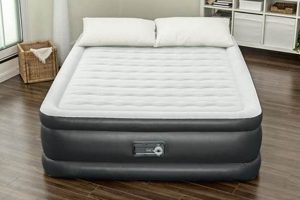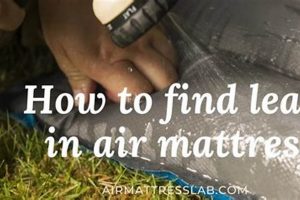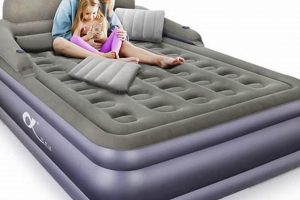A portable sleeping platform that combines the elevated support of a cot with the cushioning comfort of an inflatable mattress represents a practical solution for outdoor rest. This setup typically involves a foldable frame, constructed from materials like aluminum or steel, designed to hold an air-filled mattress. These mattresses are commonly made of durable, puncture-resistant materials such as PVC or reinforced nylon.
Such a system offers significant advantages over sleeping directly on the ground. Elevation provides insulation from cold surfaces, minimizes exposure to insects and moisture, and contributes to improved back support and overall sleep quality. The historical development of these systems reflects a gradual refinement of materials and designs, leading to lighter, more compact, and more comfortable options for outdoor enthusiasts.
The following sections will delve into specific aspects of these combination systems, including materials and construction, factors influencing user comfort, and practical considerations for selection and maintenance.
Essential Considerations for Optimal Use
Maximizing the utility and lifespan of a camping cot integrated with an air mattress requires careful attention to several key areas. Proper usage and maintenance are crucial for ensuring a comfortable and reliable sleeping experience in outdoor environments.
Tip 1: Select the Appropriate Size and Weight Capacity: Prior to purchase, verify that the dimensions of the cot and air mattress are suitable for the intended user. Exceeding the stated weight capacity can lead to structural failure of the cot frame and premature wear of the air mattress material.
Tip 2: Ensure Adequate Inflation: Correct inflation is critical for optimal comfort and support. Overinflation can lead to seam stress and potential rupture, while underinflation diminishes the cushioning effect. Refer to the manufacturer’s guidelines for recommended pressure levels.
Tip 3: Protect Against Punctures: The air mattress is susceptible to punctures from sharp objects. Always clear the area beneath the cot of debris, and consider using a protective ground cloth underneath the entire setup.
Tip 4: Employ Proper Storage Techniques: When not in use, deflate the air mattress completely and store both components in a dry, protected environment. Avoid prolonged exposure to direct sunlight or extreme temperatures, which can degrade the materials.
Tip 5: Regularly Inspect for Damage: Periodically examine the cot frame for signs of bending, cracking, or loose connections. Likewise, inspect the air mattress for leaks, abrasions, or weakened seams. Address any issues promptly to prevent further damage.
Tip 6: Utilize a Fitted Sheet: The use of a fitted sheet can enhance comfort, protect the air mattress surface from dirt and abrasion, and facilitate easier cleaning.
Adhering to these recommendations will contribute to a more comfortable and reliable outdoor sleeping experience, while simultaneously extending the lifespan of the equipment.
The subsequent sections will explore advanced features and address common troubleshooting scenarios associated with this type of sleeping system.
1. Portability and Weight
Portability and weight are critical determinants in the practicality of a camping cot integrated with an air mattress. The inherent advantage of such a system elevated sleeping and cushioning is directly balanced against the challenges of transporting and setting up the equipment. Higher weight and bulkier packed dimensions limit suitability for backpacking or situations where minimizing carried load is paramount. Conversely, designs prioritizing minimal weight may compromise durability or comfort through the use of lighter, less robust materials.
Real-world examples illustrate this trade-off. A cot constructed from lightweight aluminum alloys and paired with a thin, self-inflating air mattress offers superior portability for solo trekking but may be less supportive for larger individuals or prone to damage under harsh conditions. Conversely, a steel-framed cot with a thick PVC air mattress provides robust support and puncture resistance but significantly increases the overall weight, rendering it more suitable for car camping scenarios. The absence of these factors can lead to inconvenience.
The significance of understanding the interplay between portability and weight lies in making informed purchase decisions. Consider the primary use case: if extended hiking is involved, a lightweight, compact model is essential, even if it necessitates some compromise in comfort. For base camp scenarios, a heavier, more robust system may be preferable. Thus, effective product selection hinges on accurately assessing personal needs and activity types.
2. Frame Strength
Frame strength is a foundational element in the design and functionality of a camping cot intended for use with an air mattress. It directly influences the system’s stability, weight capacity, and overall lifespan, impacting the user’s comfort and safety. Understanding the factors that contribute to frame strength is critical for selecting a suitable product.
- Material Composition
The primary material used in the cot frame significantly affects its strength. Steel frames, while generally more robust and offering higher weight capacities, are heavier than aluminum frames. Aluminum alloys, particularly those used in aerospace applications, provide a favorable strength-to-weight ratio, making them suitable for portable cots. The choice of material dictates the cot’s ability to withstand stress and resist deformation over time.
- Joint Design and Construction
The points at which frame members connect are crucial stress points. Welded joints, particularly those employing high-quality welding techniques, offer superior strength compared to mechanically fastened joints. The design of these joints, including the use of gussets or reinforcing plates, can further enhance their ability to withstand repeated loading and prevent premature failure.
- Weight Distribution and Support Structure
The number and placement of support legs or crossbars influence how weight is distributed across the frame. A well-designed support structure minimizes stress concentrations and ensures that the frame can bear the intended load without buckling or bending. Cots with wider bases and more support points generally exhibit greater stability and weight capacity.
- Manufacturing Tolerances and Quality Control
Even with robust materials and design, inconsistencies in manufacturing can compromise frame strength. Strict adherence to dimensional tolerances, rigorous quality control inspections, and adherence to industry standards are essential for
ensuring that each cot meets the specified performance criteria. Deficiencies in these areas can result in weak points within the frame, increasing the risk of failure under load.
The interplay of material selection, joint design, support structure, and manufacturing quality collectively determines the frame’s ability to reliably support both the user and the air mattress. A compromise in any of these areas can lead to reduced weight capacity, increased susceptibility to damage, and a diminished overall lifespan. Therefore, a thorough assessment of these factors is essential when selecting a camping cot designed for use with an air mattress.
3. Mattress Material
The material comprising the air mattress component of a camping cot system significantly impacts its performance characteristics, including comfort, durability, weight, and resistance to environmental factors. The selection of an appropriate material is therefore a critical consideration.
- Polyvinyl Chloride (PVC)
PVC is a common material choice due to its relatively low cost, waterproof nature, and ease of manufacturing. However, PVC is susceptible to punctures, and its durability can be compromised by extreme temperatures. Its lack of breathability can also lead to discomfort in warm weather conditions. Repairing PVC requires specialized adhesives and techniques. The environmental impact of PVC production and disposal is also a consideration.
- Thermoplastic Polyurethane (TPU)
TPU offers enhanced durability and puncture resistance compared to PVC. It exhibits greater flexibility, making it more comfortable and less prone to cracking in cold weather. TPU is also generally considered more environmentally friendly than PVC, as it is recyclable and does not contain phthalates. However, TPU mattresses are typically more expensive than PVC alternatives.
- Nylon (with TPU or PVC Coating)
Nylon provides a strong and abrasion-resistant base material. When coated with TPU or PVC, it creates a durable and airtight barrier. This combination offers a balance of strength, flexibility, and puncture resistance. Nylon-based mattresses often feature reinforced seams and construction for added durability. However, the performance is still dependent on the quality of the coating used.
- Polyester (with TPU or PVC Coating)
Polyester shares some characteristics with nylon, offering good strength and resistance to stretching. Like nylon, it requires a coating to be airtight. Polyester is generally less expensive than nylon, making it a cost-effective option for some air mattresses. However, it is typically less abrasion-resistant than nylon and may not be as durable in demanding outdoor conditions.
The choice of mattress material represents a trade-off between cost, durability, comfort, and environmental impact. Understanding the characteristics of each material allows for a more informed decision when selecting a camping cot equipped with an air mattress, ensuring that the system meets the specific needs and demands of its intended use.
4. Inflation Mechanism
The inflation mechanism is an integral component of a camping cot system utilizing an air mattress, directly influencing its portability, setup time, and overall user experience. The functionality of the entire system hinges on the reliable and efficient inflation of the air mattress. A poorly designed or malfunctioning inflation mechanism renders the cot essentially unusable, negating the benefits of elevated sleeping and cushioning. The choice of inflation method determines the effort required for setup and the feasibility of achieving optimal mattress pressure.
Common inflation mechanisms include integrated manual pumps, separate manual pumps (foot or hand-operated), and electric pumps (AC, DC, or battery-powered). Integrated pumps offer convenience by eliminating the need for separate equipment, but often require significant physical exertion and may not achieve high pressures. Separate manual pumps provide greater control and potentially higher pressures but necessitate carrying additional gear and still require user effort. Electric pumps offer the fastest and most effortless inflation but require a power source and contribute to increased overall weight. For example, a car camper may prioritize an electric pump for convenience, while a backpacker might opt for a lightweight, compact manual pump or a self-inflating mattress design to minimize weight and reliance on external power.
Therefore, the selection of an appropriate inflation mechanism is a critical decision point when choosing a camping cot with an air mattress. Factors to consider include the intended use case, available power sources, user physical capabilities, and desired level of convenience. Understanding the trade-offs associated with each type of mechanism allows for an informed choice that maximizes the system’s practicality and ensures a comfortable and reliable sleeping experience in the outdoors.
5. Size and Capacity
Size and capacity are fundamental considerations when selecting a camping cot integrated with an air mattress. These factors directly impact user comfort, safety, and the system’s suitability for intended applications. Mismatches between the user’s physical dimensions and the cot’s specifications can lead to discomfort, inadequate support, and potential equipment failure.
- Sleeping Surface Dimensions
The length and width of the cot’s sleeping surface dictate the user’s ability to stretch out comfortably. Inadequate length can cause discomfort for taller individuals, while insufficient width may restrict movement during sleep. Standard cot dimensions may not accommodate larger individuals or those who prefer ample sleeping space. For example, a person exceeding six feet in height requires a cot with a length exceeding their height to avoid discomfort from their feet extending beyond the edge. Similarly, individuals who toss and turn frequently during sleep will benefit from a wider sleeping surface.
- Weight Capacity
The cot’s stated weight capacity represents the maximum load it can safely support without risk of structural failure. Exceeding this limit can result in bending, breakage, or collapse of the frame, potentially leading to injury. Weight capacity is determined by the materials used in the frame construction and the design of the support structure. It is crucial to select a cot with a weight capacity that exceeds the user’s weight, including any additional gear placed on the cot. Real-world examples include situations where users place heavy backpacks or other equipment on the cot, inadvertently exceeding the specified weight limit.
- Overall Footprint
The overall footprint of the assembled cot influences its suitability for use within a tent or other confined space. A larger footprint requires a larger tent, which may impact portability and setup ease. Smaller tents may not accommodate larger cots, necessitating careful consideration of dimensions prior to purchase. For instance, a spacious double tent may comfortably house two standard-sized cots, wh
ile a smaller backpacking tent may only accommodate a single, compact cot. - Air Mattress Thickness
The thickness of the air mattress affects the level of cushioning and support provided. Thicker mattresses generally offer greater comfort but may also increase the overall weight and packed size of the system. Thinner mattresses, while more compact and lightweight, may not provide sufficient cushioning for all users, particularly those with back problems or other sensitivities. Choosing an appropriate thickness balances comfort with portability and storage considerations.
These considerations collectively emphasize the importance of carefully evaluating size and capacity specifications when selecting a camping cot with an air mattress. A mismatch between these factors and the user’s needs can compromise comfort, safety, and the overall effectiveness of the system.
Frequently Asked Questions
This section addresses common inquiries regarding camping cots designed for use with air mattresses. The information provided aims to clarify misconceptions and offer guidance on selection, usage, and maintenance.
Question 1: What is the expected lifespan of a camping cot with an air mattress?
The lifespan of a camping cot and air mattress system is contingent upon several factors, including the quality of materials, frequency of use, environmental conditions, and maintenance practices. High-quality materials and careful maintenance can extend the lifespan to several years. Conversely, frequent use in harsh environments or neglect of maintenance can significantly shorten the lifespan.
Question 2: Can an air mattress be used independently of a camping cot?
Yes, an air mattress can be used independently on the ground. However, using it in conjunction with a camping cot offers several advantages, including elevation from cold or damp ground, improved back support, and reduced exposure to insects. The structural support provided by the cot is absent when the mattress is used alone, potentially compromising comfort and insulation.
Question 3: What are the key differences between steel and aluminum cot frames?
Steel frames are generally more robust and offer higher weight capacities than aluminum frames. However, steel is significantly heavier, making it less suitable for situations where portability is paramount. Aluminum frames provide a favorable strength-to-weight ratio, making them more practical for backpacking or hiking. The choice depends on the balance between weight capacity needs and transportation requirements.
Question 4: How should an air mattress be properly stored to prevent damage?
Prior to storage, the air mattress should be fully deflated and cleaned. It should then be rolled or folded loosely to avoid creating creases or stress points. The mattress should be stored in a dry, cool environment away from direct sunlight and extreme temperatures. Storage in a protective bag is recommended to prevent abrasion and puncture damage.
Question 5: Is it possible to repair a puncture in an air mattress?
Yes, small punctures in an air mattress can typically be repaired using a patch kit specifically designed for the mattress material. The damaged area must be thoroughly cleaned and dried before applying the patch. Larger punctures or seam failures may require professional repair or replacement of the mattress.
Question 6: What is the ideal level of inflation for an air mattress?
The ideal level of inflation is dependent on user preference and the manufacturer’s recommendations. The mattress should be inflated to a firmness that provides adequate support without feeling overly rigid. Overinflation can stress the seams and increase the risk of rupture. Underinflation can compromise support and comfort. It is advisable to consult the manufacturer’s guidelines for optimal inflation pressure.
The information presented above offers practical insights into commonly asked questions. Proper understanding will improve decision-making.
The next section will examine advanced features.
Final Assessment
The preceding analysis has explored the multifaceted nature of the camping cot with air mattress, elucidating critical considerations related to material selection, structural integrity, inflation mechanisms, and user-specific size requirements. A comprehensive understanding of these elements is essential for making informed purchasing decisions and ensuring the long-term performance of such systems in diverse outdoor environments. The interplay of portability, durability, and comfort demands a careful evaluation of individual needs and the specific characteristics of available products.
Ultimately, the efficacy of a camping cot with air mattress hinges on its capacity to deliver a reliable and comfortable sleeping platform that withstands the rigors of outdoor use. Continued advancements in materials and design hold the potential to further enhance the portability, durability, and overall performance of these systems, solidifying their role as essential components for outdoor recreation and preparedness.







